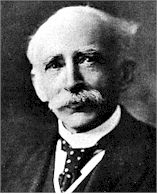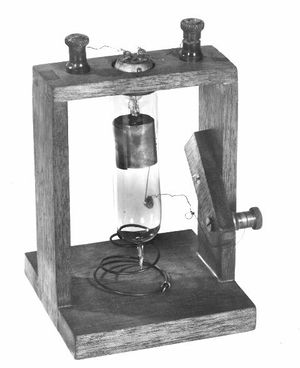John Fleming
- Birthdate
- 1849/11/29
- Death date
- 1945/04/18
- Fields of study
- Electron devices
- Awards
- Faraday Medal of the British Institution of Electrical Engineers
Biography
The son of a congregational minister, John A. Fleming was born in Lancaster, England, on 29 November 1849. He received a degree in science from University College, London, in 1870, and then was a teacher until 1877, when he enrolled at St. John's College of Cambridge University. He attended lectures by J. C. Maxwell and also did research at the Cavendish Laboratory. Fleming developed a precision resistance bridge instrument given the nickname "Fleming's banjo" and used it to compare resistance standards. He received the doctorate degree in 1879 and continued at Cambridge as a laboratory demonstrator until 1881, when he accepted a teaching position at Nottingham. He did some consulting for the Edison Electric Company on incandescent lamps. In 1885, he joined the faculty of University College, London, where he spent the rest of his professional career.
One of Fleming's early investigations was concerning the "Edison effect," where he studied the unilateral conductivity of a carbon-filament lamp with a metal plate connected to an external circuit. In December 1889, he presented a paper on this work to the Royal Society of London entitled "On Electric Discharge Between Electrodes Temperatures in Air and High Vacua." He also conducted extensive research on alternating-current which led to his publication of a two-volume work, The Alternate Current Transformer, in 1889 and 1892. He published a number of joint papers with J. Dewar during the 1890s related to the electric and magnetic properties of materials at low temperatures. Fleming was elected a fellow of the Royal Society of London in 1892.
In April 1898, Fleming was permitted to examine Marconi's wireless apparatus at the time it was being used to send messages for about 14 miles from the Isle of Wight. In late March 1899, Marconi demonstrated communication between England and France across the English Channel, an achievement that Fleming characterized as "one of those sensational feats which at once aroused the daily press to lively comment on the matter." Fleming participated in these experiments and reported the results in a letter published by The Times of London. He stated that "messages, signals, congratulations, and jokes were freely exchanged between the operators" situated on opposite sides of the channel. Later the same year, Fleming gave a lecture at a meeting of the British Association for the Advancement of Science in Dover during which wireless messages were sent and received from France. In 1900, Marconi invited Fleming to help design a more powerful wireless transmitter for an attempt to send signals across the Atlantic Ocean. The transmitter, which Fleming called the "first electric wave power station," was installed on the coast of Cornwell, and signals from it were reported to have been detected at a receiver in Newfoundland on December 12, 1901.
The application of the Fleming valve to wireless communication grew out of experiments carried out by Fleming during 1904, when he found that a high-vacuum thermionic diode would rectify high-frequency currents. He reported his observations in a 1905 paper published by the Royal Society of London, entitled "On the Conversion of Electric Oscillations into Continuous Currents by Means of a Vacuum Valve." He concluded that "an ideal and perfect rectifier for electric oscillations may, therefore, be found by enclosing a hot carbon filament and a perfectly cold metal anode in a very perfect vacuum." He suggested that the device would provide an effective means to test the performance of a wireless transmitter and determine "what changes conduce to an improvement of reduction in the efficiency of the transmitting device." Fleming also devised a wave meter that he called a "cymometer," which used the glow of a Geissler tube to indicate resonance and give a reading of wavelength on a calibrated scale. His classic book The Principles of Electric Wave Telegraphy and Telephony was published in 1906, and another book entitled The Propagation of Electric Currents in Telephone and Telegraph Conductors was published by Fleming in 1911.
Fleming retired from University College in 1926 and received the Faraday Medal of the British Institution of Electrical Engineers in 1928. He was knighted in 1929 and elected president of the Television Society of London 1930. Fleming was awarded the IRE Medal of Honor in 1933, "For the conspicuous part he played in introducing physical and engineering principles into the radio art." He died on 18 April 1945 at age 95.

